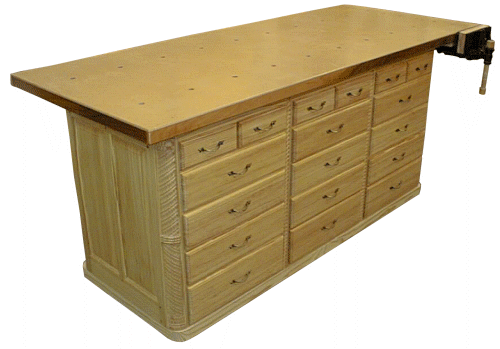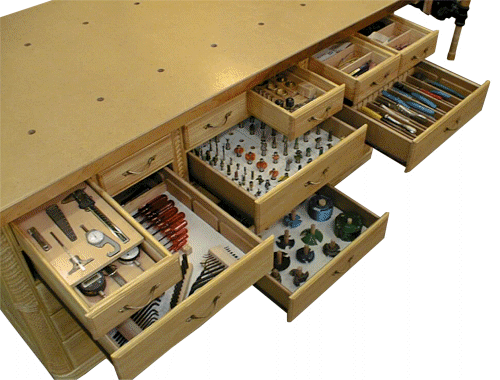|
|
|
 |
This is the third workbench I've built for my shop. The first was a simple top supported by two plywood -box columns. The second was much like the one shown here in size and form except is was built entirely of BC plywood. While the second bench served me well I wanted something a little nicer, I was tired of the plywood. |
| This design is a three-bay drawer carcass, each bay
was constructed as an individual cabinet. There are a total of 18 drawers in this
bench. I find drawers far more useful in storing items than shelves. Drawers
allow easier access, are easier to organize, and they hold more. The casework is built with a mix of Luan plywood, Melamine, and some solid wood edging. The two ends have applied raised frame and panels with a sizeable spiral quarter-round detail on all four corners. In between the middle bay and the ends is some rope-molding trim. I used a solid core door for the top. The exposed edges are wrapped in poplar. The top itself is 1/4" tempered hardboard manually nailed to the core with finish nails. This makes for an easily replaceable top should it become damaged or discolored. The exterior of the bench is solid pine that has been put through a process I call "Rip & Rotate (R&R). This R&R process is a lot of work, the reason I do it is because I like the look of quatersawn pine, it's a lot cheaper than hardwood, and I can make as much as I want. I (evidently) like doing things the hard way. |
|
| This new bench provided an excuse to get a
little more organized than I had been previously. Before I filled this one up I took
a little time to make some organizers to hold various types of tools. I used mostly scrap, MCP, and pieces of laminate flooring to create these. Although I could have done this on my previous bench, I just never took the time to do so. |
 |
| I used cheap 3/4 extension kitchen cabinet type
drawer glides on all the full-width drawers. These drawers were made of 1/2"
MDO plywood including the bottom; a drawer-lock joint was used at the corners. I
used MDO because I didn't want to spend a lot of time making the R&R pine stock.
If one looks closely, the 1/4" interior drawer divider blocks can be seen.
These allow the drawers to be compartmentalized as well as support a shallow tray
if desired. The small drawers at the top are made of 1/2" R&R pine joined with 1/4" box joints at the corners. They are fully supported by a case divider made of Melamine; they also have pull-out stops. Small drawers such as this actually work better than drawers with metal glides. Both sizes of drawers have an applied false front with a thumbnail overlay profile. I used some cheap enclosed floral pulls instead of knobs; the enclosed pulls keeps extension cords and the like from snagging on them. |
|
 |
A series of bench dog holes run the length of the top and there
are some in line with the vise as well. The two long items shown are particularly
useful when belt sanding, one is about 1/2" thick, the other about 1/4".
The other small dogs are just 3/4" pegs with 1/2" thick square tops. To make the dog holes, I used a template along with a long 1/2" spiral bit in a router equipped with a guide bushing. This method allowed me to place the holes 16" on center and 8" apart very consistently. A router makes a better hole in this case compared to a drill; the holes come out rounder and more perpendicular to the top. |